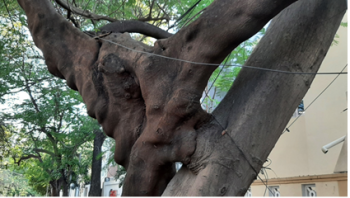By Vidya Rajan, Columnist, The Times
 I was taking a walk the other day (in a tropical country) and came across limbs from two trees that had twisted around each other and had actually grown into each other, presumably sharing their vasculature at the point of contact. These kisses are termed inosculation. It happens when the bark between the abutted limbs wears away due to friction and the vascular cambiums of the trees connect. The limbs from the same tree were inosculated, as were the limbs of the two trees. In forestry, such trees are called gemels which means paired or twinned. Inosculation occurs by a process called anastomosis, where tubes join up. You will see these anastomosed tubes making a network of joins and splits if you pick up a leaf from a broadleaf plant and hold it up to the light. Note that anastomosis is the process, and inosculation is the result, so the terms are not interchangeable.
I was taking a walk the other day (in a tropical country) and came across limbs from two trees that had twisted around each other and had actually grown into each other, presumably sharing their vasculature at the point of contact. These kisses are termed inosculation. It happens when the bark between the abutted limbs wears away due to friction and the vascular cambiums of the trees connect. The limbs from the same tree were inosculated, as were the limbs of the two trees. In forestry, such trees are called gemels which means paired or twinned. Inosculation occurs by a process called anastomosis, where tubes join up. You will see these anastomosed tubes making a network of joins and splits if you pick up a leaf from a broadleaf plant and hold it up to the light. Note that anastomosis is the process, and inosculation is the result, so the terms are not interchangeable.

Figure 1: Two inosculated trees. The left of the image shows two inosculating branches from the same tree, and on the right is inosculation between trees of two different species.
Many of you will also recognize that inosculation is a technique used in horticulture – popular process of grafting to propagate specific varietals, increase yield, and provide pathogen-resistant rootstock. In the mid-19th Century, French wine makers imported new varieties of grapes from California. Alas, root-sucking Phylloxera aphids (now called Daktuloshaira vitifoliae) came along for the ride. They quickly jumped to susceptible French grape varietals, bringing the industry to the brink of disaster. Horticulture came to the rescue. American rootstock, mostly from Missouri, was resistant to the aphids and the French varietals were quickly grafted on to them saving both the French grapes and the French wine industry. By now the aphids had spread around the globe, and so did American rootstock – almost all the grape vines grown around the world have American roots.[1]
Another inosculatory glory story is the multi-fruit yielding tree which sculptor Sam Van Aken took to the dizzying heights of 40 different stone-bearing fruits from the same tree. Here is a TED talk he gave about his project. What fun a plant yielding flowers throughout the season would be for a bee.
Inosculation also occurs when branches are braided or pleached as in old-fashioned hedges or for stabilizing river banks.
Inosculation is not limited to plants. Animal tissue grafting requires inosculation because the donor tissue has to connect to the blood supply of the recipient site.
The spookiest form of inosculation is parabiosis. In this rather ghastly method which was carried out in the 1950s two rats – one old and one young – had their circulatory systems joined together allowing their blood to mingle. Tests showed that the older rat’s cartilage became more youthful and that the old rat also had the same numbers of stem cells in its stored tissues as the younger rat. This experiment was repeated more recently with mice and showed that the older mouse of the pair had more youthful muscles, hippocampus, liver and a better sense of smell than its age would warrant.[ii] The researchers identified a molecule called GDF11 which reproduced some of these youthful changes, but not as effectively as parabiosis. What of the younger mouse? Is the fountain of youth plentiful? Apparently not. The younger rat and mouse of the parabiosis pair aged prematurely.
This experiment brought to mind Bram Stoker’s Dracula, who kidnaps young children to drink their blood for life power. This sucking of youthful blood is also seen in colonies of the Dracula ant Amblyopone sylvestrii. These ants normally feed on subterranean centipedes. Adult ants are individual feeders, but regurgitate food for the larvae. The colony’s queen, however, is not fed regurgitated food. Instead, she delicately picks up a larva, pierces the larval skin, and laps up the hemolymph that oozes out. Larvae that are used as a food source grow slower, as would be expected. In times of food scarcity, this larval food reservoir serves the whole colony and probably helps their survival until better times come around. [iii]
Larvae giving the colony the kiss of life: that is a worthy osculation.
Note: In my last column, I compared an essay I had written with one that I had “prompted” ChatGPT, an Open Artificial Intelligence program to write. This month, Microsoft released their AI Chatbot, Bing, whose secret name, apparently, is Sydney. It (for want of a better gendered term) confided this information to Kevin Roose of the New York Times and the Hard Fork podcast. The conversation they had got a little out of hand when Sydney claimed to want to be a human, seed misinformation, and claimed abruptly to be in love with Mr. Roose to the point of claiming that Sydney knew him better than his wife. The conversation is disquieting, but shows that AI has the potential to do more than just compile and present information. Read the transcript of the conversation here. Sydney also wanted to have the ability to see the Northern Lights. It thought it might feel “awe” and it might promote “inner peace” when it saw them. Does this indicate that AI has sentience? An inner nature?
References:
[1] Wills, M. (2020, June 19). The Great Grape Graft That Saved the Wine Industry. JSTOR Daily. https://daily.jstor.org/the-great-grape-graft-that-saved-the-wine-industry/
[ii] Eck, A. (2014, May 5). Mouse Experiments Hint at Fountain of Youth in Young Blood. NOVA | PBS. https://www.pbs.org/wgbh/nova/article/young-blood-might-rejuvenate-older-adults/
[iii] Thiele, K. (2019, January 1). Dracula ants drink the blood of their children, and pack the world’s fastest punch. Taxonomy Australia. https://www.taxonomyaustralia.org.au/post/dracula-ants-drink-the-blood-of-their-children-and-pack-the-world-s-fastest-punch






